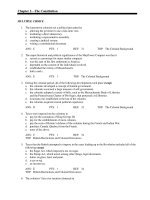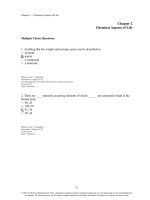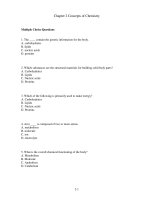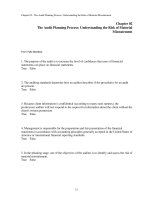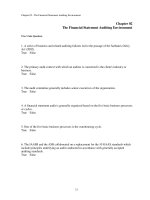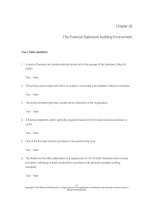American government and politics today essentials 2013 2014 17th edition bardes test bank
Bạn đang xem bản rút gọn của tài liệu. Xem và tải ngay bản đầy đủ của tài liệu tại đây (789.48 KB, 12 trang )
CHAPTER 2: The Constitution
MULTIPLE CHOICE
1. There are 538 electors in the electoral college; i.e.,
a. ten for every state.
b. one for each member of the U.S. Senate.
c. one for each member of Congress and three for the District of Columbia.
d. one for each Senator and each Governor of the state.
e. one for each U.S. Senator and three for Puerto Rico.
ANS: C
REF: 32
NOT: Applied
2. The Founders designed the system of electors to select the president because
a. they hoped the people would lobby the electors.
b. they hoped the people would delegate the selection to a group of notable citizens.
c. they believed in direct democracy.
d. they wanted a system for selecting presidents identical to Britain.
e. All of the above are true.
ANS: B
REF: 32
NOT: Applied
3. Under the electoral college system
a. a presidential candidate can be elected without receiving a majority of the popular vote.
b. a presidential candidate cannot win without receiving the majority of the popular vote.
c. a presidential candidate can win with a majority of the popular vote but a minority of the
electoral college vote.
d. more than 20 presidents have failed to win over 50 percent of the popular vote.
e. All of the above are true.
ANS: A
REF: 32
NOT: Applied
4. If the United States elected presidents by popular vote
a. small states’ interests might be ignored.
b. large states’ interests might be ignored.
c. elections might be more certain with a wider margin of victory.
d. there would be less recounts.
e. Options A and C are true.
ANS: E
REF: 32
NOT: Applied
5. As suggested by the text, one method of establishing a popularly elected president is
a. through an interstate compact in which states agree to award electoral votes to the winner
of the national popular vote.
b. by abolishing the electoral college via a vote in Congress.
c. by challenging the constitutionality of the electoral college in the Supreme Court.
d. by giving each state an equal vote.
e. Options A and B are true.
ANS: A
REF: 32
NOT: Applied
6. The winner-take-all provision of the current presidential election system
a. provides that the winner of the state’s popular vote takes all of the state’s electoral votes.
b. is sometimes called the unit rule.
c. causes some candidates to skip safe states and only campaign in close contests.
d. causes candidates to spend little time in California, Illinois, New York, and Texas.
e. All of the above are true.
ANS: E
REF: 32
NOT: Applied
7. The number of electors required to win the presidential election is
a. 270.
b. 470.
c. 170.
d. 720.
e. 538.
ANS: A
REF: 32
NOT: Factual
8. In the voting booth, during presidential elections, citizens
a. vote for candidates directly.
b. vote for electors who are pledged to support one candidate or another.
c. vote for a political party rather than a candidate.
d. vote for a slate of presidential electors.
e. All of the above are true.
ANS: B
REF: 32
NOT: Applied
9. The Jamestown colonists set a political precedent by
a. allowing the governor to use a line-item veto.
b. instituting a direct democracy.
c. instituting a representative assembly.
d. creating a judicial system.
e. writing a constitutional document.
ANS: C
REF: 33
NOT: Applied
10. The creative thinkers that designed the Constitution were most influenced by
a. the historical and political context of the civil war.
b. political philosophy of the time about how people should be governed.
c. the historical experiences gained through trial of several forms of government during New
World settlement.
d. the historical experiences gained through trial of several forms of government during Old
World settlement.
e. Options B and C are true.
ANS: E
REF: 33
NOT: Conceptual
11. The Jamestown colony was established as
a. a trading post.
b. a military fort.
c. a settlement in Maryland.
d. the first French settlement in the New World.
e. a settlement for religious Separatists.
ANS: A
REF: 33
NOT: Applied
12. The colonies in the New World provided for opportunities to
a. promote trade.
b. explore religious freedom.
c. practice limited self-government.
d. implement the social contract.
e. All of the above are true.
ANS: E
REF: 33 | 34
NOT: Applied
13. The major historical and political significance of the Mayflower Compact was that it
a. served as a prototype for many similar compacts.
b. was the start of the first settlement in America.
c. depended on the consent of the individuals involved.
d. established the colony of Massachusetts.
e. Options A and C are true.
ANS: E
REF: 34
NOT: Conceptual
14. Taxes were imposed on the colonists to
a. pay for the coronation of King George III.
b. pay for the establishment of more colonies.
c. pay the costs of Britain’s defense of the colonies during the French and Indian War.
d. to enrich wealthy British landowners.
e. None of the above is true.
ANS: C
REF: 35 | 36
NOT: Factual
15. Taxes that the British attempted to impose on the American colonies in the years leading up to the
Revolutionary War included all of the following except
a. the Sugar Act, which imposed a tax on sugar.
b. the Stamp Act, which taxed legal documents and newspapers.
c. duties on glass, lead, and paint.
d. a tax on tea.
e. an income tax.
ANS: E
REF: 36
NOT: Factual
16. The colonists’ fury over taxation led to
a. a boycott of British goods.
b. the formation of the Stamp Act Congress.
c. the closure of Boston Harbor.
d. the Boston Tea Party.
e. All of the above are true.
ANS: E
REF: 36
NOT: Factual
17. The First Continental Congress
a. declared independence from Britain.
b. was held in Boston, Massachusetts.
c. urged colonists to purchase British goods to win favor with the King.
d. encouraged the colonists to petition King George III to express their grievances.
e. produced a document that the colonists found to be coercive.
ANS: D
REF: 36
NOT: Factual
18. One of the main actions of the Second Continental Congress was
a. to establish an army and appoint a commander in chief.
b. to sign a treaty with Britain prohibiting trade with France.
c. to sign a treaty with France to declare war on Britain.
d. the creation of a unitary government in America.
e. to establish a document with ambitious designs to separate from Britain.
ANS: A
REF: 36 | 37
NOT: Factual
19. Thomas Paine’s pamphlet Common Sense advocated
a. the formation of a new government that would still be loyal to the king.
b. the establishment of a government that would limit further immigration.
c. an end of hostilities toward Britain.
d. the idea that the formation of the country’s own government was a “natural right.”
e. the repeal of all taxes, including those the colonists had imposed on themselves.
ANS: D
REF: 36 | 37
NOT: Conceptual
20. The first draft of the Declaration of Independence was written by
a. John Locke.
b. John Adams.
c. Thomas Jefferson.
d. George Washington.
e. Benjamin Franklin.
ANS: C
REF: 37
NOT: Factual
21. “We hold these Truths to be self-evident, that all Men are created equal” are the first words of
a. the Constitution of the United States of America.
b. the Declaration of Independence.
c. the Magna Carta.
d. the United Nations Charter.
e. the Bill of Rights.
ANS: B
REF: 37 | 38
NOT: Factual
22. Which of the following is not true of the Declaration of Independence?
a. It listed the colonists’ grievances against England.
b. It established the legitimacy of the United States as a new nation.
c. It listed reasons for dissolving the tie with Great Britain.
d. It established a constitutional government.
e. It gave the people the rights to life, liberty, the pursuit of happiness and to alter the
government if it became destructive of the people’s rights.
ANS: D
REF: 37–39
NOT: Factual
23. A voluntary agreement among individuals to secure their rights and welfare by creating a government
and abiding by its rules is called
a. a confederation.
b. a social contract.
c. a syndicate.
d. a constitution.
e. natural law.
ANS: B
REF: 38
NOT: Factual
24. English philosopher John Locke believed that the main purpose of government was
a. to defend against foreign enemies.
b. to protect man’s natural rights of life, liberty, and property.
c. to raise taxes to build an army.
d. to promote equality under the law.
e. to promote religious separatism.
ANS: B
REF: 38
NOT: Conceptual
25. The term confederation or confederal refers to
a. a system in which most power is with the central government.
b. a voluntary association in which states have most of the power.
c. a system in which state and local governments have equal power with the
central government.
d. a national legislature.
e. the southern states where slavery was legal.
ANS: B
REF: 40
NOT: Conceptual
26. The Articles of Confederation
a. provided for a bicameral legislature.
b. established a strong executive branch.
c. allowed the states to retain most of the power.
d. created a way to raise taxes to fund an army.
e. ended slavery.
ANS: C
REF: 40
NOT: Factual
27. Which of the following was a weakness of the Articles of Confederation?
a. Congress lacked the power to collect taxes directly from the people.
b. Any amendments to the Articles required unanimous consent of the Congress and
confirmation by every state legislature.
c. Congress lacked the power to demand funds for the militia.
d. Each state had one vote regardless of size.
e. All the above are true.
ANS: E
REF: 40 | 41
NOT: Factual
28. The Constitutional Convention in 1787 was brought on by the
a. publication of the Treaty of Paris.
b. request of President Washington.
c. failure of the Articles of Confederation.
d. publication of the Declaration of Independence.
e. end of the Revolutionary War.
ANS: C
REF: 42
NOT: Factual
29. Of the delegates at the Constitutional Convention
a. most were members of the upper class.
b. a majority came from professional backgrounds.
c. most represented a cross section of American society.
d. most were senior statesmen with governmental experience.
e. Options A and B are true.
ANS: E
REF: 42
NOT: Applied
30. The Virginia Plan
a. called for a bicameral legislature.
b. worked to the advantage of small states.
c. provided for the direct election of a president by the people.
d. settled all controversy.
e. Options B and C are true.
ANS: A
REF: 43
NOT: Factual
31. The factions among delegates at the Constitutional Convention
a. wanted a strong central government.
b. were concerned about claims to western lands.
c. had republican leanings.
d. had nationalist leanings.
e. All of the above are true.
ANS: E
REF: 43
NOT: Applied
32. The New Jersey Plan called for all of the following except
a. Congress would elect several people to form an executive office.
b. the elimination of a Supreme Court.
c. the ability of Congress to regulate trade and impose taxes.
d. acts of Congress would be the supreme law of the land.
e. the principle of one state, one vote.
ANS: B
REF: 44
NOT: Factual
33. The supremacy doctrine asserts the superiority of
a. large states over small states.
b. non-slave states over slave states.
c. national law over state law.
d. natural law over man-made law.
e. None of the above is true.
ANS: C
REF: 44
NOT: Conceptual
34. The Great Compromise
a. was advanced by the delegates from Georgia.
b. proposed a bicameral legislature with equal representation in the Senate.
c. was presented too late to be considered.
d. was proposed by Texas.
e. proposed a unicameral legislature in which each state would have one vote.
ANS: B
REF: 44
NOT: Factual
35. The Three-Fifths Compromise did all of the following except
a. illustrate the power of the southern states at the convention.
b. partially apportion the House of Representatives and the electoral college on the basis
of property.
c. give African Americans representation that was equal to what free whites received.
d. give more voting power to southern slave owners.
e. fail to address the slave trade directly.
ANS: C
REF: 44 | 45
NOT: Applied
36. All of the following are true except
a. the Three-Fifths Compromise did not end slavery.
b. the compromise meant that slavery was never addressed directly.
c. the representatives elected in the South did not represent slaves.
d. the Three-Fifths Compromise allowed the immediate ban on the importation of slaves.
e. delegates believed that dismemberment of the union was a worse evil than slavery.
ANS: D
REF: 44 | 45
NOT: Applied
37. The United States is among the few countries that do not tax their exports because
a. it does not need the money.
b. it encourages exports.
c. the South obtained a promise that export taxes would not be imposed.
d. the World Trade Organization prohibits it from doing so.
e. the president of the United States vetoed the bill.
ANS: C
REF: 45
NOT: Applied
38. The concept of separation of powers was included in the Constitution to prevent
a. disputes between the federal and state governments.
b. the imposition of export taxes.
c. a major dispute over power between the House and the Senate.
d. disputes over power between Congress and the president.
e. tyranny by either the majority or by a minority.
ANS: E
REF: 46
NOT: Conceptual
39. Which of the following is NOT correct under the concept of separation of powers?
a. The president executes and carries out the law.
b. The Supreme Court uses judicial review.
c. The legislative branch’s job is lawmaking.
d. Congress has the right to interpret the law.
e. None of the above is true..
ANS: D
REF: 46
NOT: Applied
40. The concept of checks and balances allows
a. Congress to declare presidential actions unconstitutional.
b. the Supreme Court to break the tie on legislation.
c. the President to veto legislation he/she does not support.
d. Congress to remove members of the Supreme Court.
e. Options A and B are true.
ANS: C
REF: 46
NOT: Applied
41. The group that actually elects the president of the United States is called
a. the Presidential Election Commission.
b. the Congressional Election Forum.
c. the Association of State Legislatures.
d. the electoral college.
e. the electorate at large.
ANS: D
REF: 47
NOT: Factual
42. When the Constitution was approved in 1787, it included
a. a federal system.
b. separation of powers.
c. popular sovereignty, or control by the people.
d. a representative government.
e. All of the above are true.
ANS: E
REF: 47 | 48
NOT: Conceptual
43. The Constitution included all of the following except
a. a republican form of government.
b. limited government with written laws.
c. a unicameral legislature.
d. protections for states’ rights.
e. checks and balances.
ANS: C
REF: 48
NOT: Applied
44. The Federalists
a. supported the new Constitution.
b. were mostly rural people from the lower classes.
c. did not attend the Constitutional Convention.
d. supported the status quo.
e. Options B and C are true.
ANS: A
REF: 48 | 49
NOT: Factual
45. Ratification of the Constitution required the
a. approval of the thirteen state legislatures.
b. approval by nine out of thirteen state conventions.
c. approval of the thirteen state legislatures and two-thirds of Congress.
d. approval by popular vote in nine states.
e. None of the above is true.
ANS: B
REF: 48–50
NOT: Factual
46. The Anti-Federalists
a. lived in urban areas.
b. attended the Constitutional Convention.
c. supported a strong central government.
d. opposed the new Constitution.
e. Options A and B are true.
ANS: D
REF: 49 | 50
NOT: Factual
47. National support for the Constitution was probably
a. widespread as the wealthy landowners wanted to protect their property rights.
b. widespread as a strong central government protected order.
c. limited as the poor were oppressed by wealthy elite.
d. limited as the wealthy did not want to extend voting rights to the masses.
e. Both A and B.
ANS: E
REF: 51
NOT: Applied
48. The Bill of Rights provided for
a. the protection of individual liberties from state governments.
b. the protection of individual liberties from the national government.
c. equal protection under the law.
d. protection against state infringements on the freedoms of conscience, the press, and
jury trial.
e. Options B and D are true.
ANS: B
REF: 51–53
NOT: Conceptual
49. The Bill of Rights
a. is sometimes called the Bill of Limits.
b. is sometimes called the Bill of Attainder.
c. is the first Ten Amendments to the Constitution.
d. limited state power.
e. Options A and C are true.
ANS: A
REF: 51–53
NOT: Factual
50. A constitutional amendment can be proposed by
a. a national convention called by Congress at the request of two-thirds of the
state legislatures.
b. a two-thirds vote in each chamber of Congress.
c. the legislatures in two-thirds the states.
d. a majority vote in both chambers of Congress provided the amendment is not vetoed by
the president.
e. Options A and B are true.
ANS: E
REF: 53 | 54
NOT: Factual
51. A constitutional amendment can be ratified by
a. a positive vote in conventions in three-fourths of the states.
b. a positive vote in the legislatures of three-fourths the states.
c. a two-thirds vote in both houses of Congress.
d. the legislatures in two-thirds of the states.
e. Options A and B are true.
ANS: E
REF: 53 | 54
NOT: Factual
52. Which groups are involved in proposing and ratifying amendments to the Constitution?
a. The states, the president, and Congress
b. The Senate, the Supreme Court, and the House of Representatives
c. Congress, the president, and the people
d. The Senate, the House of Representatives, and the states
e. The House of Representatives, the president, and the Senate
ANS: D
REF: 53 | 54
NOT: Applied
53. The only formal method used so far to propose an amendment to the Constitution is
a. the popular vote of the people.
b. a two-thirds vote in favor of it by both houses of Congress.
c. state legislatures or conventions in three-fourths of the states.
d. a national convention.
e. a proposal by the president.
ANS: B
REF: 53 | 54
NOT: Factual
54. The framers of the Constitution set
a. no time limit for the ratification process.
b. a limit of twelve months for the ratification of an amendment.
c. a limit of twenty-four months for ratification for the ratification of an amendment.
d. a seven year limit for ratification of an amendment.
e. a provision for extensions for ratification.
ANS: A
REF: 54
NOT: Applied
55. The voting age of eighteen was set by
a. Congress.
b. the Twenty-sixth Amendment.
c. the Nineteenth Amendment.
d. the Supreme Court.
e. the states.
ANS: B
REF: 55
NOT: Factual
56. Informal methods of constitutional change include
a. Congress proposing an amendment with a three-fourths majority of both houses.
b. state governments changing their constitutions to give them supremacy.
c. the use of judicial review by the courts.
d. state governments agreeing to hold conventions to amend the Constitution.
e. All of the above are true.
ANS: C
REF: 56 | 57
NOT: Conceptual
57. The power of the Supreme Court to declare actions of the other branches of government to be
unconstitutional is known as
a. judicial review.
b. judicial activism.
c. legislative ratification.
d. the supremacy doctrine.
e. the Madisonian model.
ANS: A
REF: 57
NOT: Factual
58. Judicial review is
a. a method by which the president can check the judiciary.
b. the process of confirmation of federal judges by Congress.
c. the ability of the courts to declare acts of the legislative and executive branches of
government unconstitutional.
d. not applicable to actions by state governments.
e. None of the above is true.
ANS: C
REF: 57
NOT: Conceptual
59. International agreements between the president and a foreign head of state that do not require
legislative approval are known as
a. treaties.
b. executive agreements.
c. contracts.
d. memoranda of understanding.
e. executive orders.
ANS: B
REF: 57
NOT: Factual
60. Opponents of the 2010 Patient Protection and Affordable Care Act
a. believe that individuals should not be forced to buy health insurance by the government.
b. believe that government will next tax those who are overweight, smoke or buy
foreign cars.
c. believe that healthcare is a right.
d. believe that the government does not have the right to impose new taxes.
e. Options A and B are true.
ANS: E
REF: 59
NOT: Applied
ESSAY
1. Describe the purpose of the various colonial settlements and the motivations for emigration to the New
World.
ANS:
Answers may vary.
2. Describe the colonists’ dissatisfaction with the British restrictions and steps they took to begin the road
to the Constitutional Convention.
ANS:
Answers may vary.
3. Describe the competing interests of the small states and the large states. How were these conflicting
interests resolved in the final version of the Constitution in 1787?
ANS:
Answers may vary.
4. Describe the concepts of separation of powers and checks and balances and give examples of these
checks in each branch of government.
ANS:
Answers may vary.
5. Describe the methods of proposing and ratifying a constitutional amendment.
ANS:
Answers may vary.
6. Compare and contrast the structures of government formed under the Articles of Confederation and the
U.S. Constitution. How are the colonists’ historical experiences reflected in each document? How did
the weaknesses of the Articles lead to a different structure in the Constitution?
ANS:
Answers may vary.
7. At the Constitutional Convention, several compromises were made to garner the support of various
states. Describe these compromises and the debates that surrounded them.
ANS:
Answers may vary.
8. The Constitution’s ratification process included arguments for and against ratification by Federalists
and Anti-Federalists, respectively. Describe and evaluate the arguments expressed by both of
these groups.
ANS:
Answers may vary.
9. The process of amending the U.S. Constitution is an intentionally difficult one. Yet those in each
branch of government have found ways in which the Constitution can be changed informally. Describe
the methods, both formal and informal, of constitutional change.
ANS:
Answers may vary.
10. Describe the demographic make-up of the delegates to the Constitutional Convention. Did they
represent a cross-section of American Society?
ANS:
Answers may vary.


